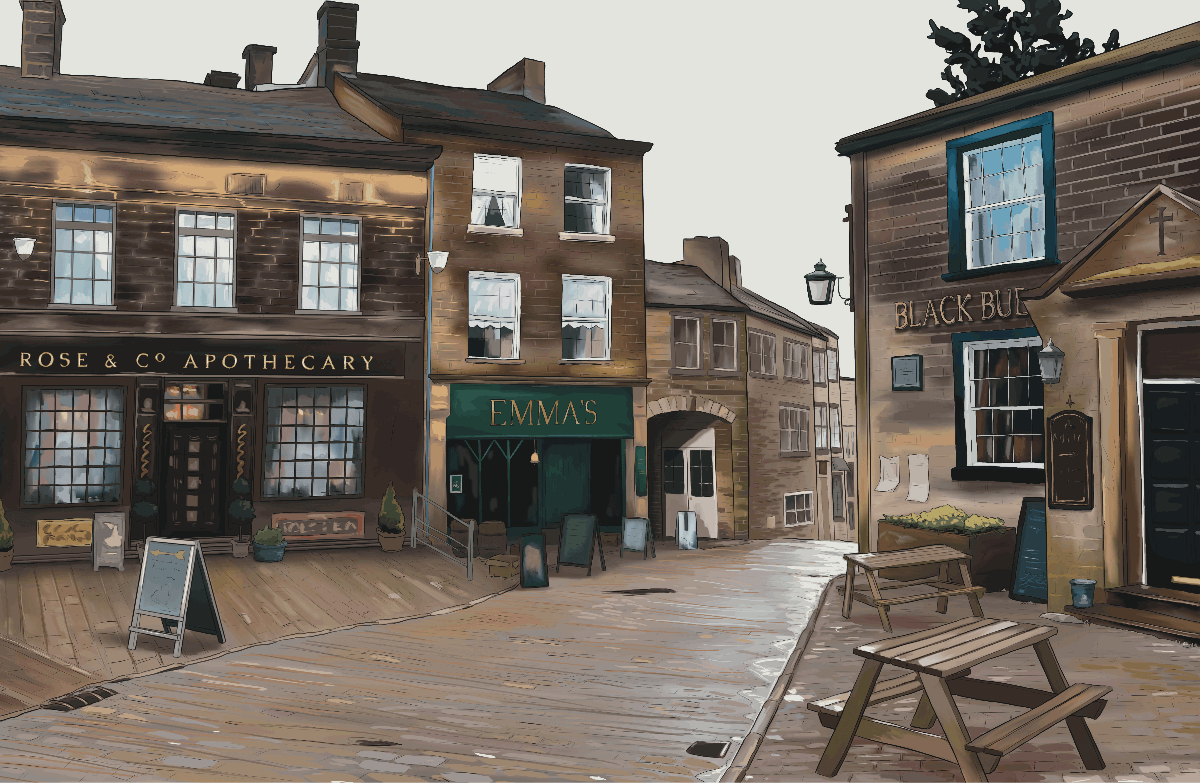How to draw backgrounds better than you ever have before! This guide gives detailed tips on how to draw better backgrounds. It covers ten topics and goes into specific tips for each one. This drawing guide is perfect for beginners and advanced artists alike. Also, it will help artists learn to make backgrounds that can be used for whatever their field, including hobby art, comics, book illustration, decor, or stationery. So, continue reading to quickly improve your sketching and painting skills.
Overview of How to Draw Backgrounds
Below is a list of the topics covered in this how to draw backgrounds guide.
- Using References
- Nailing Your Perspective
- Blocking Out Your Sketch
- How to Draw Backgrounds with Depth
- Thinking in Grayscale
- How to Shade Better
- Choosing Good Compositions
- Using Stylization
- How to Draw Backgrounds from Imagination
- Practice Makes Perfect
1. Using References
The first step to draw better backgrounds is to use references. This can include referencing real life, other artworks, or photographs. Additionally, you can reference educational materials, such as books, tutorials, and speedpaint videos. (Make sure to follow proper copyright laws though when using reference that does not belong to you.)
Despite the misconception, using references when drawing is not cheating. Also, despite another misbelief, using references does help you improve at drawing backgrounds. For example, studying the forms, colors, sizes, etc. of trees from real life will help you to more accurately depict them in your background drawings.
Below, you can see the reference photo I used to do a background study of a town. By replicating the photo brushstroke by brushstroke, I took in much more detail than if I had just glanced at it. Additionally, by recreating the photo, I learned what buildings look like, how wet streets shine from rain, etc.
Now you have learned how using references can help improve your background drawings. For specific tips on how to use references in your art, read Tips for Using References in Your Art.
2. Nailing Your Perspective
The second step to drawing better backgrounds is nailing your perspective. Inaccurate perspective can be distracting or confusing to the viewer of your background drawings. That is why it is important to learn how to use perspective properly. Additionally, when applied well, perspective can help give some “extra oomph” or the right mood to a background drawing.
So, to draw better backgrounds, make sure to study horizon lines, vanishing points, how to make things to scale, etc. Looking for somewhere to start learning perspective? You can check out these books to help you learn the fundamentals of perspective drawing: Successful Drawing & Perspective Made Easy. #affiliatelinks
3. Blocking Out Your Sketch
Another helpful tip to draw backgrounds is to block out your sketch. Put simply, this means doing a quick, loose sketch before drawing more detailed. Similarly, you can also start your background drawing by doing some tiny thumbnails to decide on the best composition and layout.
Doing these things ensures you do not waste time detailing a part of your drawing only to realize the perspective is off or the scale is all wrong. Likewise, blocking out your sketch helps to ensure your drawing will have good readability and clear silhouettes. Furthermore, it will help you figure out where your perspective lines should go and to determine the best framing for your background drawing.
Below you can see how I first blocked out a sketch for my background study. You can see how I did not worry about making perfectly straight or clean lines in the beginning phases of the study. Instead, I focused on getting things the right scale and angle. I used my sketch as an underdrawing to make the next round of sketching easier, faster, and more accurate.
4. How to Draw Backgrounds with Depth
Most background drawings look best with a good sense of depth. So, here are some tips on improving your background drawings by adding depth:
Firstly, create depth in your backgrounds by incorporating a foreground, middleground, and background. Make these areas distinct from each other to add extra readability to your background as well. Secondly, if trying to add depth, choose “camera angles” that are not straight on. This will show more planes of objects at once, causing them to appear more three dimensional. This leads to the third tip, which is to think in 3D. Try to incorporate cubes rather than squares and cylinders rather than circles into your drawing. Fourthly, use shading to help add depth. Also, try blurring the background or foreground to create depth of focus. Likewise, you can add less details to things that are far away to create depth. Finally, you can incorporate atmospheric perspective to landscapes to give your backgrounds more depth.
5. Thinking in Grayscale
An additional tip for drawing better backgrounds is to think in grayscale. This means visualizing or literally turning your background drawing into grayscale to ensure a variety of things. For example, that the background has good readability, contrast, shapes, focal points, and depth. Likewise, using dark tones in the foreground and lighter tones in the background helps add depth to a background drawing. Putting a drawing into grayscale helps make it more obvious if your background is following this rule. So, to temporality turn your background into grayscale, use a drawing program or black and white camera filter.
Still confused how viewing your background in grayscale helps? Look at my background drawing below as an example. Temporarily making the drawing grayscale helps me more easily see that I have enough dark and light colors – also known as contrast. And good contrast helps the drawing have good clarity and depth. Additionally, it helps me see which areas of the background are receiving the most attention – also known as the focal points. If one of these areas are noticeably lacking, I can turn a drawing back into full color and try to fix the problem. That is why thinking in grayscale is helpful for achieving nice backgrounds.

6. How to Shade Better
Another important part of drawing good backgrounds is shading. The actual shapes and lines may be the most crucial parts to a good background drawing, but shading is an element that can take your backgrounds to the next level. Of course, there are many online tips and tutorials easily accessible that teach how to shade better. However, here a few important tips about shading: Determine the direction of your light source, focus on shadows and highlights, and do not over blend.
7. Choosing Good Compositions
When learning how to draw backgrounds, a valuable skill to learn is how to choose good compositions. In other words, choosing appropriate layouts to use in your drawings. If used correctly, composition can help you achieve the correct vibe you desire your background to give off. For example, you can use composition to give off a peaceful, exciting, or shocking feel. To achieve good composition in your background drawings, study framing, camera angles, and focal points.
Additionally, good composition is extremely important for comics. That is actually why I did this background study. It is to help me get better at drawing backgrounds for my comic, Kindred Not.
8. Using Stylization
Another important tool to help you draw backgrounds is stylization. Sometimes, breaking away from realism can help you create even more amazing backgrounds. Stylization can also be used to simplify a background and make it faster to draw. Also, stylization can add clarity or spunk to a background drawing. It can even help achieve a better flow or composition in your drawing.
To use stylization, try exaggerating, simplifying, changing colors, etc. Also, study different famous stylized art styles or create your own. Furthermore, do not be afraid to stray from realism. As mentioned, using various methods of stylization can help you achieve the right feel or look to your backgrounds.
9. How to Draw Backgrounds from Imagination
Although drawing realistically or from reference are great methods to practice drawing backgrounds, sometimes artists want to create their own original backgrounds. By doing so, artists are able to avoid copyright issues and/or are able to depict the ideas in their head.
However, there really is no such thing as drawing from “imagination” or “originality.” Everything an artist draws is based on conscious and subconscious things they have previously seen or learned about. So, in order to draw original backgrounds, artists must first learn about backgrounds. For instance, if you want to draw a town from imagination, you need to know things about towns and about drawing. So, to draw better towns from imagination, it helps to first know a lot about towns and about drawing. Likewise, it helps to practice all the previously mentioned tips for drawing backgrounds.
One more tip for drawing from imagination, is to combine multiple references. This way you can create something one a kind and call it your own original work. Additionally, when drawing interiors, try doing an overhead sketch of the room first. Drawing aerial, blueprint angles is pretty fast and easy, so it helps you plan out the layout of a room before investing time drawing it from a more complex angle. This tip is also helpful for when you need to draw the same room consistently from multiple angles. For example, I will need to do this when making my upcoming comic.
10. Practice Makes Perfect
Finally, the most important part of drawing backgrounds is to actually practice drawing backgrounds. It is great to read and learn about drawing backgrounds, but it is also great to experiment and test your knowledge. When drawing backgrounds, avoid tracing, even when doing studies, as this does not help as much as free-handing your own backgrounds. Also, remember to break out of your comfort zone and try to draw challenging or new types of backgrounds. Moreover, try doing a mixture of sketches and finished illustrations. You can get more practice in just doing sketches of backgrounds, but it is nice to make some polished backgrounds as well.
I have been using these tips to practice making backgrounds for my comic, Kindred Not. For instance, the background painting below is a study I created of an old town. By making this drawing, I am now better able to create original backgrounds for my comic. With time and effort, I know you too can improve at drawing backgrounds, as practice makes perfect.
I Hope You Liked These Tips on How to Draw Backgrounds!
If you enjoyed learning about these tips to draw backgrounds, I would love to know. So, share a comment below on your favorite tips from this article.
Also, read more tips about drawing and comics. And subscribe for more content like this.

 Rolex Milgauss 116400GV Green Dial
Rolex Milgauss 116400GV Green Dial 